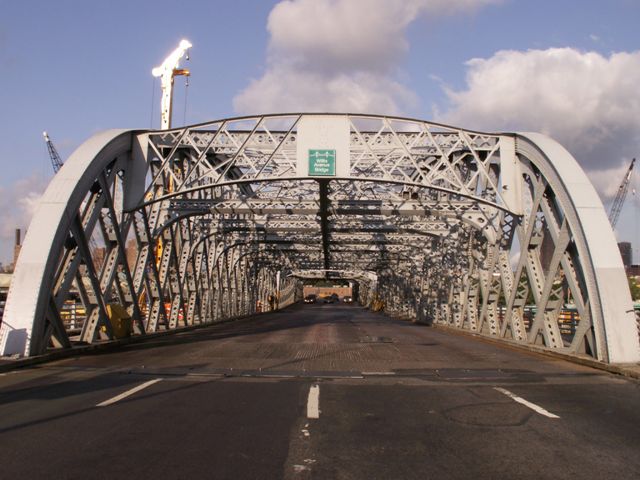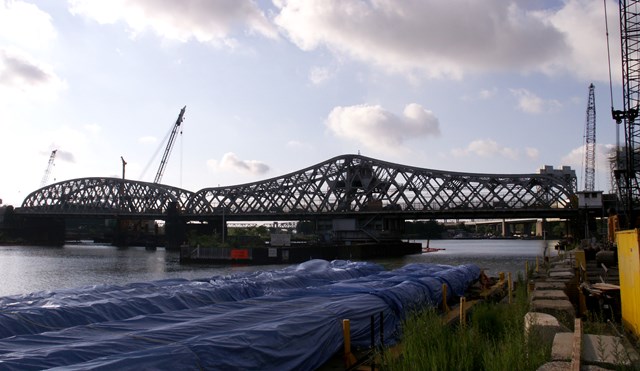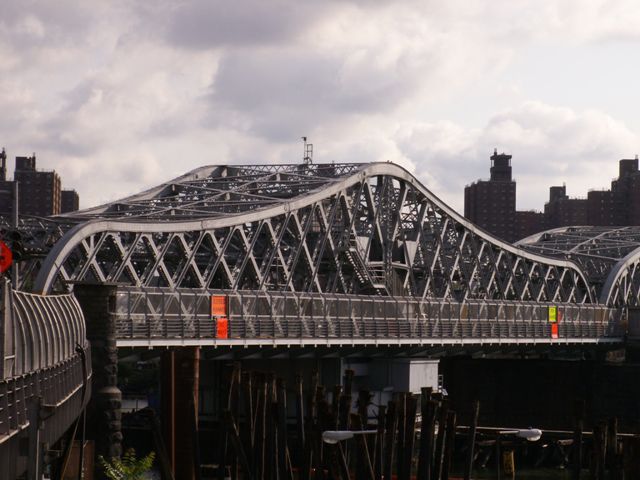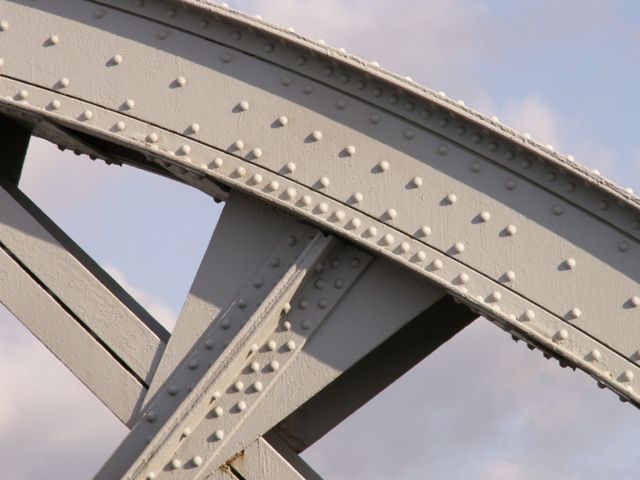We Recommend:
Bach Steel - Experts at historic truss bridge restoration.
BridgeHunter.com Phase 1 is released to the public! - Visit Now
Willis Avenue Bridge

Primary Photographer(s): Nathan Holth and Rick McOmber
Bridge Documented: July 1, 2008
New York: The Bronx, New York and Manhattan, New York: United States
Metal Rivet-Connected Lattice (Quadruple Warren) Through Truss, Movable: Swing (Rim Bearing Center Pier)
1901 By Builder/Contractor: Edge Moor Bridge Works of Wilmington, Delaware and Engineer/Design: Thomas Curtis Clarke
1987
304.0 Feet (92.7 Meters)
3,212.0 Feet (979 Meters)
42 Feet (12.8 Meters)
1 Main Span(s) and 24 Approach Span(s)
2240059

View Information About HSR Ratings
Bridge Documentation
This bridge no longer exists!
View Archived National Bridge Inventory Report - Has Additional Details and Evaluation
This historic bridge was demolished by New York City DOT October 2010!
Download The Original Plans For This Historic Bridge (Large 464mb ZIP file of PDFs)
| Additional Technical Facts |
| Truss Approach Span Length | Sidewalk Width | Navigation Clearance When Closed | Bridge Width |
| 250 Feet (76.2 Meters) | 2 @ 9 Feet (2.7 Meters) | 25 Feet (7.6 Meters) | 60 Feet (18.3 Meters) |

This bridge is perhaps one of the most beautiful examples of functional architecture ever seen. Old truss bridges of any kind are usually beautiful, presenting a unique and intricate geometric art that gets more complex the more you study a truss bridge, noting not only the truss web, but any v-lacing/lattice, bracing systems, variations from panel to panel, railings, etc. The Willis Avenue takes it two steps further. First, it employs the warren Quadrangular truss design, a more complex and unusual truss design that brings out a beautiful pattern of diamond-like shapes in the truss web, that most truss bridges do not show. However, its most noteworthy design that it brings to the table that so many truss bridges do not have in their design is smooth, graceful curves in the design. Many truss bridges have polygonal top chords, but most of these are just that... polygons... a series of straight sections linked together to form an overall curve shape. Indeed most swing bridges are known for this design, due to the unique cantilever-like design of a bridge with a support in the middle of the river, and none on the ends when it is opening. The Willis Avenue Bridge is different, however. It has no clunky-like shapes to its top chord. Rather, it truly has a curved top chord, and it is curved very smoothly and beautifully. The Willis Avenue Bridge has very little superficial non-structural decoration, with the exception of some knee bracing and barricade railing. Any designer can take a bridge and add superficial decorations. Its the most common way today that engineers (attempt) to make bridges look nice. They build an ugly superstructure and attach little stones, railings, and other facades to try to cover up the ugly slab of concrete doing the work. However, with many older bridges, and most distinctly with the Willis Avenue Bridge, its beauty is directly derived from careful, attentive design of the actual superstructure itself. With its curved trusses webbed together by an intricate and uncommon truss configuration, the superstructure doubles as a beautiful decoration on the Harlem River. A closer look at this truss web further reveals gusset plates which stabilize the members, present where the diagonal members intersect. These gusset plates serve a functional purpose, yet also serve a visual purpose especially when seen from a distance, where they accent the diamond shapes created by all the diagonals.
The Willis Avenue Bridge has no giant arched towers like the Brooklyn Bridge. It has no ornate, decorative builder plaque on top of the portal. It just has one of the most beautiful designs of truss superstructure ever built.
It is worth noting that the stationary truss approach span on the Bronx side is technically a warren Quadrangular truss with a top chord that could either be described as a bowstring or polygonal top chord. Either way, the presentation of a Warren quadrangular truss with anything but parallel top chords is extremely rare, and may be one of the only examples of this kind in the country.
In 1916, the bridge was renovated and strengthened to support a trolley line on the bridge.
Original plans for the bridge show that the structure originally had beautiful, ornate hand railing. The bridge also had several designs of lamps on the bridge, all decorative in design as well. The piers also had structures on top which were designed to have a finial-like look to them and were part of the aesthetics of the bridge.
Another interesting feature that was added a few years after the bridge was built were "comfort stations" which were bathrooms provided for pedestrians. There were two buildings, one for men and one for women. These were located at the Manhattan end of the bridge.
There is more that makes New York special than just the Brooklyn Bridge. The Willis Avenue Bridge is one such example. The City of New York offered this bridge to a third party as required by federal law. However, what individual or small group could hope to have the money and location for a large bridge like this? The restoration of this bridge should be a job for the government, especially since its restoration is something everyone in the general public would be able to enjoy. The city should have been the party that took the bridge, and relocated it to a suitable place if it was really true that the bridge could no longer serve Willis Avenue traffic even without substantial restoration.
The Harlem River appears to be the forgotten river. There are (or were) many beautiful bridges on the Harlem River. A couple are preserved, many others have been or will be demolished. There should be more to visiting New York City's bridges than the East River. Perhaps visitors to the city simply do not know about the Harlem River bridges, but if that is the case, than there is a potential for increased tourism-based income in the city along the Harlem River, if the city were to promote them as part of a historical tour. At the rate they are being replaced however, there will be very few historic bridges left on the river soon. The preservation of a couple bridges on the river is good news, but with all that is being demolished a lot of unique bridges and the sense of variety of bridges on the river will be lost. It will also make it difficult to promote a "bridge tour" on the river when all such a tour has to offer are a couple historic bridges. The end result is a significant loss of history, and a loss of potential tourism dollars and local economic benefit for the Harlem River area.
Demolishing and replacing this bridge will cost an incredible 612 Million dollars! The city of New York claimed that maintaining the existing bridge was costly. However, if the city had 612 Million dollars at its disposal, it bears wondering if the money could not have gone toward restoring the existing bridge and correcting the problems with the approach span to work with the historic bridge for a similar cost.
The replacement bridge at the location will also be a "truss bridge" but that is where the similarity will end. As a modern truss bridge, built-up beams with attractive v-lacing and lattice will not be present. Instead, bland rolled beams will be used. Also, on historic bridges like the historic Willis Avenue Bridge, rivets add to the geometry of the bridge by adding texture, but with their smooth, round heads they also do not make the bridge's beams look "clunky" where they are connected. The new bridge will instead have these clunky bolts, or simple welds, which add nothing in the way of beauty to the bridge. The architectural design of the truss web will be lost in the new bridge also, as the new bridge will use a simple subdivided warren truss design (instead of Warren quadrangular), and the top chord will be straight sections forming a simple five-slope "camelback" instead of the original bridges smooth curve design.
Finally, it is worth noting that there was another bridge on the Harlem River built to the same design as the Willis Avenue Bridge, which was the Third Avenue Bridge which was demolished a few years before the Willis Avenue Bridge replacement. If preserving the Willis Avenue Bridge was truly impossible, than perhaps the city should have considered preserving the Third Avenue Bridge more seriously. At least one of these unique pair of structures should have been saved.
![]()
Photo Galleries and Videos: Willis Avenue Bridge
Structure Overview
Original / Full Size PhotosA collection of overview photos that show the bridge as a whole and general areas of the bridge. This gallery offers photos in the highest available resolution and file size in a touch-friendly popup viewer.
Alternatively, Browse Without Using Viewer
![]()
Structure Details
Original / Full Size PhotosA collection of detail photos that document the parts, construction, and condition of the bridge. This gallery offers photos in the highest available resolution and file size in a touch-friendly popup viewer.
Alternatively, Browse Without Using Viewer
![]()
Structure Overview
Mobile Optimized PhotosA collection of overview photos that show the bridge as a whole and general areas of the bridge. This gallery features data-friendly, fast-loading photos in a touch-friendly popup viewer.
Alternatively, Browse Without Using Viewer
![]()
Structure Details
Mobile Optimized PhotosA collection of detail photos that document the parts, construction, and condition of the bridge. This gallery features data-friendly, fast-loading photos in a touch-friendly popup viewer.
Alternatively, Browse Without Using Viewer
![]()
Maps and Links: Willis Avenue Bridge
This historic bridge has been demolished. This map is shown for reference purposes only.
Coordinates (Latitude, Longitude):
Search For Additional Bridge Listings:
Bridgehunter.com: View listed bridges within 0.5 miles (0.8 kilometers) of this bridge.
Bridgehunter.com: View listed bridges within 10 miles (16 kilometers) of this bridge.
Additional Maps:
Google Streetview (If Available)
GeoHack (Additional Links and Coordinates)
Apple Maps (Via DuckDuckGo Search)
Apple Maps (Apple devices only)
Android: Open Location In Your Map or GPS App
Flickr Gallery (Find Nearby Photos)
Wikimedia Commons (Find Nearby Photos)
Directions Via Sygic For Android
Directions Via Sygic For iOS and Android Dolphin Browser
USGS National Map (United States Only)
Historical USGS Topo Maps (United States Only)
Historic Aerials (United States Only)
CalTopo Maps (United States Only)









